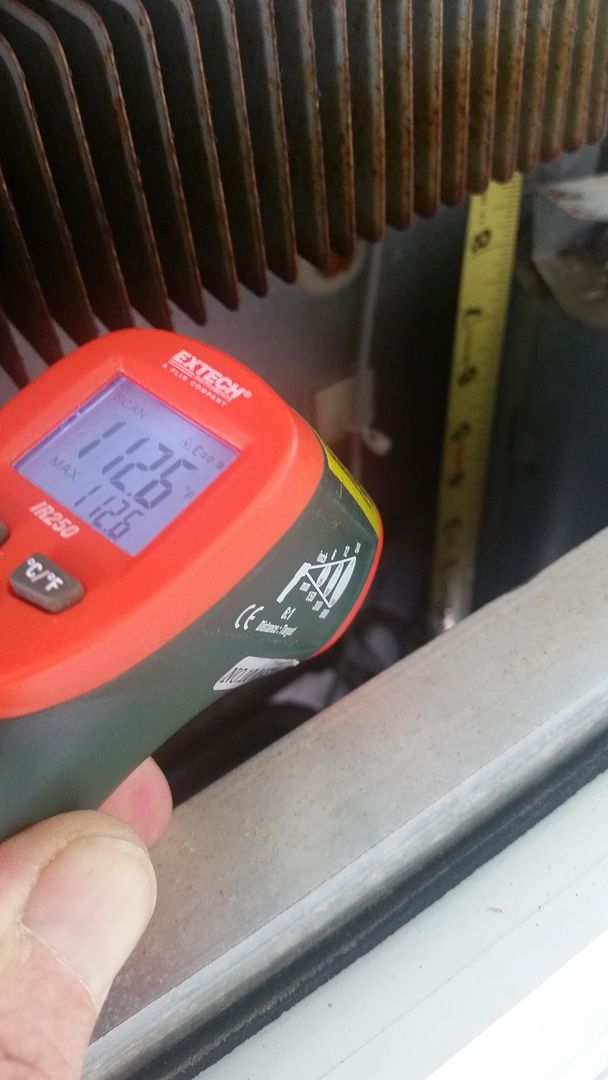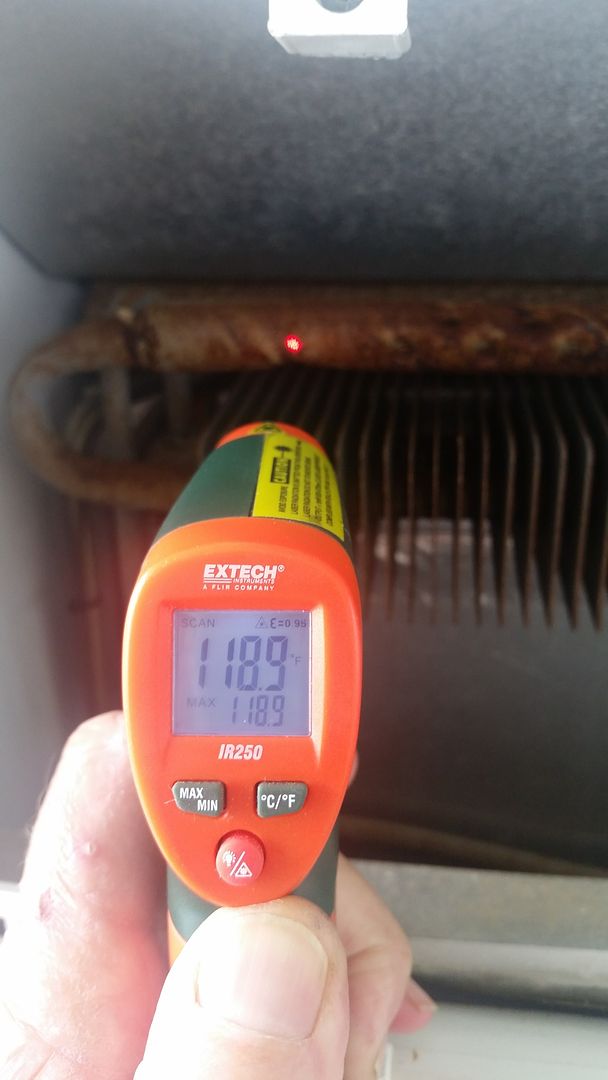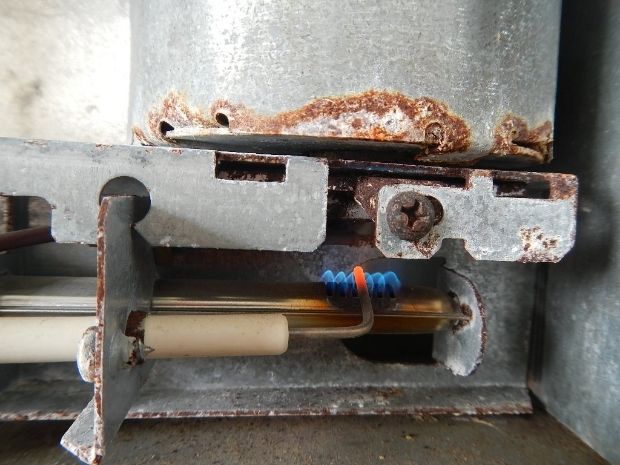- Good Sam Community
- Everything RV
- Technical Issues
- Re: Fridge Flue Temperature
- Subscribe to RSS Feed
- Mark Topic as New
- Mark Topic as Read
- Float this Topic for Current User
- Bookmark
- Subscribe
- Mute
- Printer Friendly Page
Fridge Flue Temperature
- Mark as New
- Bookmark
- Subscribe
- Mute
- Subscribe to RSS Feed
- Permalink
- Report Inappropriate Content
Apr-07-2016 05:46 AM
So, now it was time to check it on gas. I started again with the refer' area at 70*. I turned the rotary control to gas, held in the "gas-on" button and pushed the Piezo sparker. I had lit the cook top burners previously to purge the gas line but I was still pleasantly surprised when the little flame indicator jumped up after only the second click. I had the "temp" setting at "MAX" and after about two hours the thermometer in the fridge was only down to 54*. I could feel considerable heat coming out of the upper sidewall vent. I checked some temps with an IR gun and I found a whopping 400 degrees when checking on the little deflector plate right over the top of the flue tube. Down by the burner I found 160* or so on the base of the stack. Up the stack on the outside of the insulation it was only around 120*. I had heard in the past that over heating the cooling unit can wreck it and that 400* reading surprised me that it was that high so I shut it down. I could find nothing anywhere about what temperature to expect.
This fridge is fairly old but has been used little. Mostly sitting idle not being in service. I'm in Florida and I had noticed immediately that there were no bug screens on the vents so to make sure the mud dobbers hadn't plugged things up, I removed the top deflector, pulled out the spiral baffle hanging on a wire in the flue and used a mirror and flashlight to look down the "barrel". I was pleased to see that it was clean as a whistle with no rust and appeared to be lightly galvanized or something similar. The bottom of the baffle was discolored due to heat. I removed the burner shroud to have a look at the flame and it looked fine. Nice consistent blue, well defined flame.(I will try to attach a picture)
Opinions and thoughts on the operation of this would be welcome. I'm wondering...
1. Do I dare run it for a long time with that 400* flue temp?
2. What is the expected flue temp?
3. How long should it take for the gas system to bring the refer
section down to 38* or so?
4. If it is cooling on 120AC does that mean I don't have the
dreaded "crystal build-up/blockage?
5. If there is some crystal buildup inside the cooling unit
will running it for long periods on 120AC dissolve them back into
solution and improve performance?
South West, Florida
2009 Leisure Travel Serenity
- Mark as New
- Bookmark
- Subscribe
- Mute
- Subscribe to RSS Feed
- Permalink
- Report Inappropriate Content
Apr-08-2016 05:24 PM
dougrainer wrote:Travelin2 wrote:
Thanks for that doug. Makes sense.
AND, the older Bypass Refers did NOT require a Power Source to run and cool. Just a constant supply of LP. Doug
I never gave that a thought but I see what you mean, the piezo sparker is self sufficient so you could run the fridge with the disconnect switch off. Course then you would have no gas sniffers working. I think I finally got the picture thing figured out. This is the rig you helped me with. You can see the vents are not that far apart.

South West, Florida
2009 Leisure Travel Serenity
- Mark as New
- Bookmark
- Subscribe
- Mute
- Subscribe to RSS Feed
- Permalink
- Report Inappropriate Content
Apr-08-2016 09:10 AM
Travelin2 wrote:
Thanks for that doug. Makes sense.
AND, the older Bypass Refers did NOT require a Power Source to run and cool. Just a constant supply of LP. Doug
- Mark as New
- Bookmark
- Subscribe
- Mute
- Subscribe to RSS Feed
- Permalink
- Report Inappropriate Content
Apr-08-2016 05:29 AM
South West, Florida
2009 Leisure Travel Serenity
- Mark as New
- Bookmark
- Subscribe
- Mute
- Subscribe to RSS Feed
- Permalink
- Report Inappropriate Content
Apr-08-2016 04:41 AM
Travelin2 wrote:Chris Bryant wrote:
From the pics, that install is not great. The space should be baffled to the condenser (top) coils, so all air has to flow over them. The spec is now pretty much zero clearance to the back.
Thanks for chiming in Chris. I have been reading a lot of old threads about fridges including numerous posts of yours and other who have helped me here. I have learned a lot.
I did read some threads concerning the distance between the coils and the enclosure. Mine measures 4 inches air gap. I will take you advice and fabricate a baffle. I think I read somewhere that cutting a piece out of a section of galvanized AC ducting pipe works well.
I do have a question that you probably have the answer to. This older fridge is of the manual ignition (Piezo) type so the unit does not have the ability to shut down the heating flame and reignite it. So, that being the case, when running on gas and the fridge reaches the desired level of coolness, like on setting #4 on the knob, how does the unit cut down on the cooling effect applied to the freezer/refer area of the refridgerator?
Older LP refers have a BYPASS Tstat. When the temp is reached, the Tstat drops the LP flame down to what some will call a "pilot" flame. Too small to percolate but enough to stay running. Doug
- Mark as New
- Bookmark
- Subscribe
- Mute
- Subscribe to RSS Feed
- Permalink
- Report Inappropriate Content
Apr-08-2016 04:30 AM
Chris Bryant wrote:
From the pics, that install is not great. The space should be baffled to the condenser (top) coils, so all air has to flow over them. The spec is now pretty much zero clearance to the back.
Thanks for chiming in Chris. I have been reading a lot of old threads about fridges including numerous posts of yours and other who have helped me here. I have learned a lot.
I did read some threads concerning the distance between the coils and the enclosure. Mine measures 4 inches air gap. I will take you advice and fabricate a baffle. I think I read somewhere that cutting a piece out of a section of galvanized AC ducting pipe works well.
I do have a question that you probably have the answer to. This older fridge is of the manual ignition (Piezo) type so the unit does not have the ability to shut down the heating flame and reignite it. So, that being the case, when running on gas and the fridge reaches the desired level of coolness, like on setting #4 on the knob, how does the unit cut down on the cooling effect applied to the freezer/refer area of the refridgerator?
South West, Florida
2009 Leisure Travel Serenity
- Mark as New
- Bookmark
- Subscribe
- Mute
- Subscribe to RSS Feed
- Permalink
- Report Inappropriate Content
Apr-07-2016 06:46 PM
- Mark as New
- Bookmark
- Subscribe
- Mute
- Subscribe to RSS Feed
- Permalink
- Report Inappropriate Content
Apr-07-2016 05:28 PM
South West, Florida
2009 Leisure Travel Serenity
- Mark as New
- Bookmark
- Subscribe
- Mute
- Subscribe to RSS Feed
- Permalink
- Report Inappropriate Content
Apr-07-2016 12:58 PM
Unless you fully understand the absorption cooling process you are just reading numbers which have no meaning to you
Buy the way.......all temp readings are good
Fridge is functioning as designed.
For your reading pleasure
2007 DODGE 3500 QC SRW 5.9L CTD In-Bed 'quiet gen'
2007 HitchHiker II 32.5 UKTG 2000W Xantex Inverter
US NAVY------USS Decatur DDG31
- Mark as New
- Bookmark
- Subscribe
- Mute
- Subscribe to RSS Feed
- Permalink
- Report Inappropriate Content
Apr-07-2016 11:09 AM
- Mark as New
- Bookmark
- Subscribe
- Mute
- Subscribe to RSS Feed
- Permalink
- Report Inappropriate Content
Apr-07-2016 10:54 AM
doug...thanks for posting those numbers. Makes me feel like maybe I'm not going to melt things down after all. I went out and measured down 8 inches from the top of the flue and checked the temp.

Then I checked the temp of this tube in two places, Does that temp difference spell good or bad?


South West, Florida
2009 Leisure Travel Serenity
- Mark as New
- Bookmark
- Subscribe
- Mute
- Subscribe to RSS Feed
- Permalink
- Report Inappropriate Content
Apr-07-2016 09:41 AM
- Mark as New
- Bookmark
- Subscribe
- Mute
- Subscribe to RSS Feed
- Permalink
- Report Inappropriate Content
Apr-07-2016 07:54 AM
- Mark as New
- Bookmark
- Subscribe
- Mute
- Subscribe to RSS Feed
- Permalink
- Report Inappropriate Content
Apr-07-2016 07:45 AM

trying to add a picture...

South West, Florida
2009 Leisure Travel Serenity
- Mark as New
- Bookmark
- Subscribe
- Mute
- Subscribe to RSS Feed
- Permalink
- Report Inappropriate Content
Apr-07-2016 07:38 AM
South West, Florida
2009 Leisure Travel Serenity
- Norcold N821 inconstant cooling in Technical Issues
- Dometic RM3604 LP not re-igniting in Technical Issues
- Older Norcold fridge issue in Technical Issues
- Remote measurement of fridge and freezer temperatures in Technical Issues
- absorption refrigerator out of level, boiler temp control in Technical Issues





